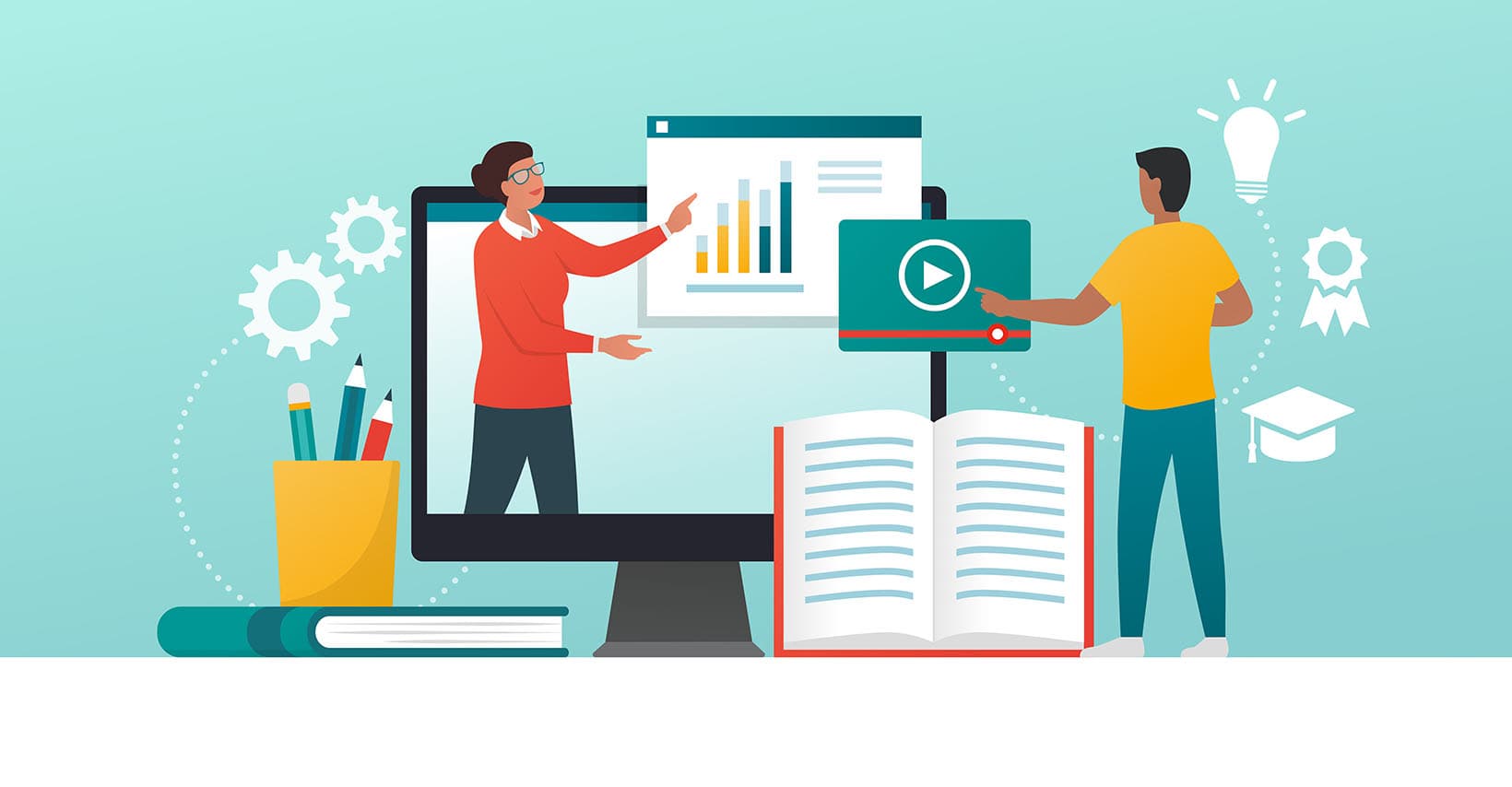“Dear professor, due to the current sanitary situation, we must ask you to deliver your course remotely”. How many teaching professionals received a similar message almost one year ago? Probably thousands of us. What was our feeling back then? Anxiety? Excitement? Probably a mix of both. But, as we were in a crisis situation, we did not really have time to deal with those feelings and had to react fast - but how? Does remote teaching simply mean lecturing behind a webcam? Probably not. Before providing the reader with some personal tips and tricks, here is a three step simple plan to convert a traditional face-to-face course into distance learning.
Distance learning - a three step plan
Building a stone house is not the same job as building a wooden house. The same applies to distance learning and face-to-face. Most of the time, what keeps your students attentive and focused is your energy, your body language, in a nutshell, your presence. One way or another, your non-physical presence in distance learning has to be replaced by something else. The one million dollar question is by what? Let’s try now to transform, step by step, a 2-hour face-to-face lecture into distance learning.
Step 1. Choose your lecturing format: synchronous vs. asynchronous
In distance learning you have basically two ways to deliver your teaching: asynchronously or synchronously (live session). Analyse carefully your regular face to face outline. Is it a lecture that you would consider above average in terms of difficulty? Is it a lecture where you usually interact a lot with students? Is it a lecture during which students must solve several exercises? Is there any group work planned?
After having analysed carefully your outline, decide whether to prepare a fully synchronous lecture or a lecture mixing a synchronous time and some asynchronous preparation. For instance, if your lecture is one where you don’t need to explain many new concepts but mostly need to discuss previously learned concepts, then, a fully synchronous lecture could be the most appropriate. On the other hand, if your lecture is a key one with some less straightforward concepts, then it's worth preparing some asynchronous material for students to read up about first and then deepen their knowledge during the live online session.
To note: If your students are used to following your classes and lectures in the traditional face-to-face classroom mode, going fully asynchronous is risky. Such a big change in the teaching method could be destabilizing for the students and yourself.
INVEST IN EDUCATION TOOLKIT
With this 10-step process, you will have all the tools you need
to master the critical areas of a successful school.
Step 2. Be as engaging as possible
Students' attention in a face-to-face lecture does not last 2 hours. The current academic literature is debating about the real attention span of students. Maybe 15 minutes, could be less, could be a bit more, but certainly not 2 hours. Bradbury (2016) concludes that attention is a subjective concept; the attention span of students relies on a variety of factors and may therefore range from few minutes to around 1 hour. Some other studies tend to show that a key driver of attention is the actual teacher and not necessarily the format of teaching.
What about students' attention in distance learning? Well, it depends, and this is where you can make a difference. Geri et al. (2017) show that if, for instance, you produce some videos for your students, their attention will depend on the interactivity of your video. According to their findings, without any activity a student's attention span watching a video will be around 6 minutes. With some embedded activities, attention may grow to over 10 minutes. In distance learning, your agenda must show not only the content you are going to cover but also all the activities you will set-up as this will be the key factor in determining your students' attention. Of course, try to diversify activities so that the student is constantly activated and remains engaged.
For instance, if your regular face-to-face lecture was, first, 45 minutes of ex cathedra explanations, try to convert those 45 minutes into slots of 10 to 15 minutes with some activities in between. If you decide to produce a video that students must watch before class to cover the content of the 45 face-to-face minutes, make your video interactive! You can, for instance, insert quizzes or links that students have to follow to answer a precise question. Tools to make interactive videos or to help you with distance learning exist and can be of great help.
To note: distance learning does not have to lead to a decrease in the academic level of your course. However, as the number of activities increases, you may have to cover a bit less material.
Step 3. Check your students' attention
Even if you may have a decrease in attendance compared to your traditional lectures (as many of us observed), do not take it personally and focus on the students who are connected. If a student connects, it is most probably because their intrinsic motivation lead them to your session. The only thing you have to do then, is provide them with this additional (extrinsic) motivation to stay tuned. This does not necessarily mean a grade bonus, it can simply be by means of your numerous and diversified activities (c.f. step 2), or due to your positive and engaging attitude. Concretely, you can simply check their attention by frequently interacting with them or by asking short questions from time to time. Find ways of staying connected with them, always.
To note: in distance learning the group effect does not really exist anymore. This means that more students may skip your lectures. You can try to retrieve them, but in any case, do not pass your frustration (if any) onto the students who are connected.
Tips and tricks
- Adapt but keep your rules. In a distance learning framework, we may, for practical reasons not impose any rules. This may lead to awkward situations or a less structured lecture. For instance, my students are aware that if they are connected I can ask them a question at anytime and that no reaction from their side will not be accepted. It may seem a bit strict, but if you were in a face-to-face lecture, you would probably not accept a student watching a movie during class, would you?
- Make students interact with each other. If you create breakout/parallel rooms, make sure they exchange with each other. Otherwise, if you do an exercise, discuss a reading, ask a question, etc, ask 2 or 3 students to unmute themselves and behave as moderators. In a face-to-face class, students interact and this greatly facilitates their learning. You may want to recreate this during your distance learning lecture.
- Increase the number of breaks. For instance, if you have a 2-hour live session, pause for a 5-6 minute break every half an hour. Ask them to open a window and breathe. Do the same!
- If the platform you use has a chat, use it wisely. Keep in mind that if a student is typing a question, he is not paying attention to your talk anymore. If you however ask students to unmute themselves to ask a question, the student just needs to click on one button. By the way, ask frequently if students have questions. This may lead to more questions as students will feel more comfortable asking a question if there is a dedicated time rather than disturbing you (as during a traditional class).
Migrating from face-to-face to distance learning is not an easy exercise for students or professors. In remote learning there is one major setback: the distance between you and your students. Mastering well a few technological tools will help you decrease this distance and gain in interactivity, students' motivation and your own fulfilment. I miss the traditional classroom a lot and the contact with my students, but I remain positive because the whole remote situation has allowed me learn how to build wooden houses in addition to stone ones.
References
- Bradbury, N. A. (2016). Attention span during lectures: 8 seconds, 10 minutes, or more?. Advances in physiology education, 40(4), 509-513.
- Geri, N., Winer, A., & Zaks, B. (2017). Challenging the six-minute myth of online video lectures: Can interactivity expand the attention span of learners?. Online Journal of Applied Knowledge Management (OJAKM), 5(1), 101-111.





